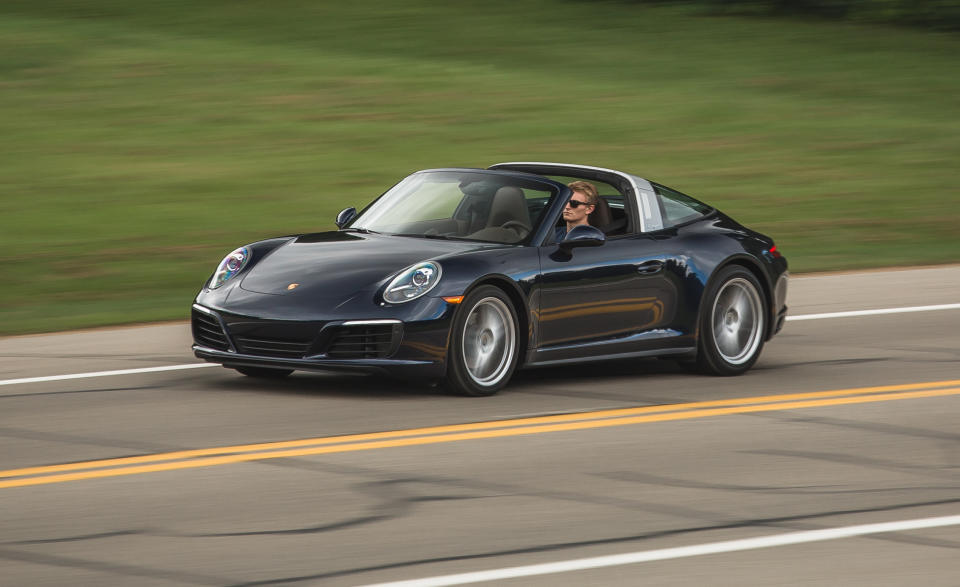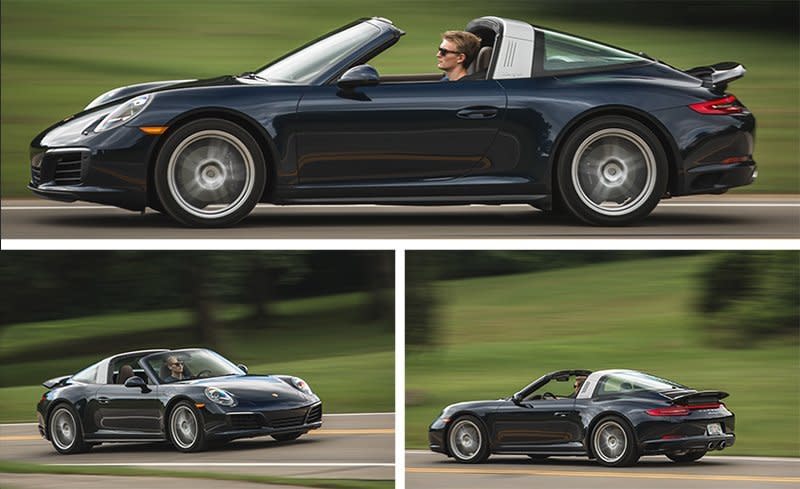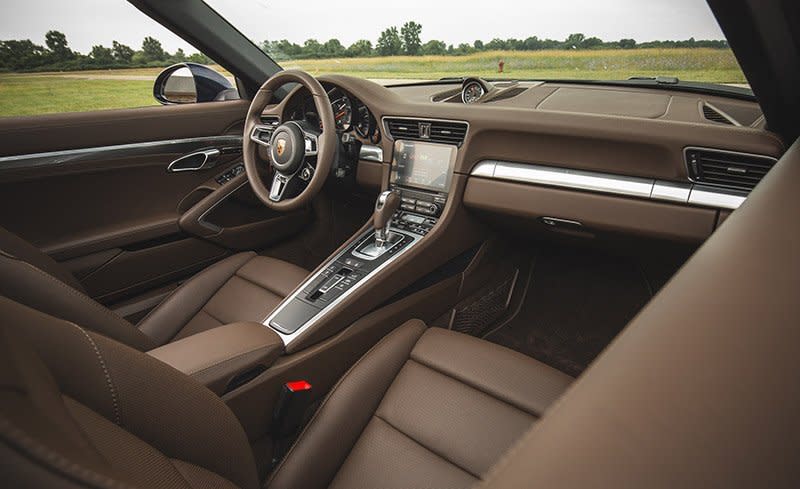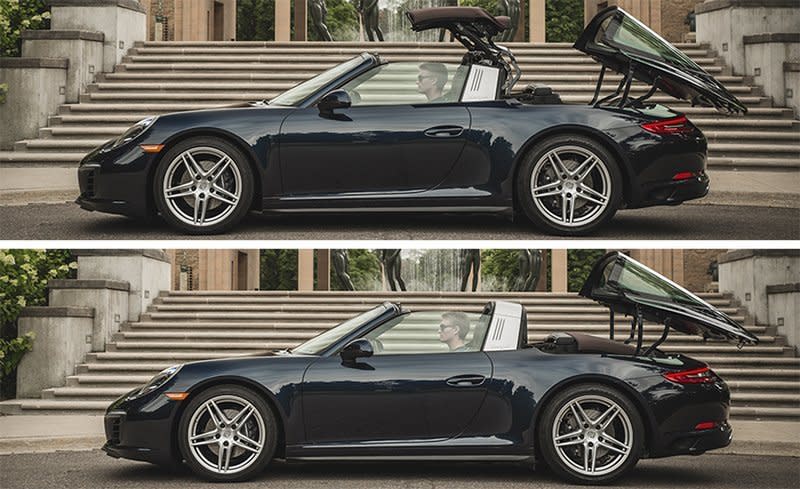2017 Porsche 911 Targa 4 PDK Automatic

Porsche has built its enviously profitable business around the luxury of choice. Choices such as 22 current variants of the 911 sports car that anchor its lineup and, within each individual model, hundreds of opportunities to select colors, materials, and features that can as much as double the already steep starting prices. But when you’re about to indulge and plunk down $100K-plus, it should take some time and care to get your car configured just so. (Pro tip: Some options are even free, such as the Smoking package, which nets an additional 12-volt outlet.)
Speaking of choice, in this latest 991-generation car, Porsche transformed the roof of the Targa model from what was essentially an oversize sunroof in the past three generations into a second convertible option, a complex folding-softtop variant that brings with it some of the visual cues and charm of the Targas from the 1960s and ’70s. There’s one thing that can’t be chosen with today’s Targa, though: rear-wheel drive. But the Targa’s starting price is the same $109,650 as the closest, all-wheel-drive cabriolet ragtop relative.

Someone spent time lovingly ticking the order sheet on this particular example, the brown fabric roof and characteristic brushed-silver hoop/B-pillars providing a brilliant contrast to the deep Night Blue Metallic paint ($710). Those pillars create significant blind spots, however, which is no doubt why—check—our test car came with the $850 blind-spot-warning system.
The wraparound rear glass is particularly captivating, in part because there’s no prominent antenna or defroster grid muddying the spectacle. But heed the warning to “check between roof mechanism and surroundings” that flashes during top actuation, as the glass cantilevers out past the rear bumper during the top-down transformation—pausing the roof in its awkward middle state and then contorting around the mechanisms is how one adds a quart of engine oil—and is no doubt part of the reason the operation is allowed only while parked. Had Tiger Woods been piloting one of these when things with his then wife got clubby, he would have discovered that the replacement cost for the stunning glass is an equally stunning $8600. We appreciate Porsche’s subtler detail work on the Targa, too, where the iconography in the digital gauge display and on the roof switch is Targa-specific. Some automakers might have simply used the cabrio’s icons and called it a day, but not Porsche.
Performance Comes Standard
Our Targa 4 test car—the least powerful version, with its 370-hp twin-turbocharged 3.0-liter flat-six and quick-shifting PDK dual-clutch automatic ($3200)—bolted to 60 mph in 3.6 seconds, so your money is probably better spent on some optional niceties rather than a power upgrade. Consider a leather interior ($3850) mandatory; ours was rendered in sumptuous Saddle Brown. The cost for going more quickly than this by stepping up to the 420-hp 4S or 450-hp GTS models ranges from about $5000 to nearly $20,000 per tenth of a second improvement in zero-to-60-mph time, and where are you going to put that performance to use, anyway? Plus, in this current turbocharged engine lineup that launched as part of the 991.2 update for 2017, there are no displacement increases to be had until you reach the capital-t Turbo models. So the off-the-line, part-throttle response in day-to-day commuting duty before the boost comes online doesn’t suffer any.

That sweet Porsche flat-six melody that we’ve known and loved for decades is still present in these latest twin-turbo torque luggers, although the intensity isn’t quite what it was in the days of natural aspiration, even with the $2950 Sport Exhaust (we recorded 90 decibels at wide-open throttle versus 93 in a 2014 test of a naturally aspirated Targa). And Porsche needs to program in some variability to the identical quartet of exhaust crackles that robotically happen when backing out of the throttle in Sport mode (they disappear in Normal and Sport+) to make them seem less phony.
Although we find the “coasting” feature (only when in Normal mode) awkward—where the engine speed drops to idle when lifting off of the throttle at speed and the engine aggressively shuts off at vehicle speeds as high as 5 mph when performing an auto-stop—this new twin-turbo 3.0-liter does make good on the promise of improved fuel economy. It returned an impressive 31 mpg on our 75-mph highway fuel-economy loop, 3 mpg better than the EPA highway rating.
How Much Convertible Do You Want?
We like that driving with the Targa’s top down at highway speeds doesn’t create a swirling gale hurling through the cabin as can happen in the cabrio. Raise the windows and extend the little pop-up windscreen from the windshield header, which does an effective job of diverting air over the occupants’ noggins, and, even at 80-mph highway speeds, one’s coif barely flutters and cabin conversation is possible.

The usual 911 goodness is present here, with supportive seats and sweetly progressive brake actuation. There’s real feel coming through the steering wheel—cause for celebration in these days of electric power assist—even though the quivers aren’t quite as vivid as they were when the 911 featured hydraulic assist.
The downside here is weight. With both the heavy roof mechanism and the mandatory all-wheel drive, our car clocked in at a plump 3614 pounds. That’s 212 more than the last Carrera 4 coupe we tested (also equipped with PDK) and some 300 greater than a rear-drive coupe. The extra weight, combined with the base 19-inch wheels and Yokohama Advan Sport tires, resulted in this car turning in the lowest cornering performance of the latest 911s we’ve tested, at 0.99 g—the only 991.2 to fall short of the 1.00-g threshold. This car also displayed more understeer and generally didn’t drive as playfully as other 911s we’ve tested recently. And the structural rigidity of the Targa is palpably less solid as well. With the top up, sharp impacts reverberate up through the open rear area, and, at low speeds between the whistling of the turbos spooling up, we noticed some creaking emanating from the top itself.
We’re torn: We love the way the Targa looks but wish it didn’t come along with the extra heft and weakened structure that dulls the 911 experience. Choices, choices.
Specifications >
VEHICLE TYPE: rear-engine, all-wheel-drive, 2+2-passenger, 2-door targa
PRICE AS TESTED: $128,170 (base price: $112,850)
ENGINE TYPE: twin-turbocharged and intercooled DOHC 24-valve flat-6, aluminum block and heads, direct fuel injection
Displacement: 182 cu in, 2981 cc
Power: 370 hp @ 6500 rpm
Torque: 331 lb-ft @ 1700 rpm
TRANSMISSION: 7-speed dual-clutch automatic with manual shifting mode
DIMENSIONS:
Wheelbase: 96.5 in
Length: 177.1 in
Width: 72.9 in Height: 50.7 in
Passenger volume: 70 cu ft
Cargo volume: 4 cu ft
Curb weight: 3614 lb
C/D TEST RESULTS:
Zero to 60 mph: 3.6 sec
Zero to 100 mph: 9.2 sec
Zero to 130 mph: 15.9 sec
Zero to 150 mph: 23.3 sec
Rolling start, 5–60 mph: 4.8 sec
Top gear, 30–50 mph: 2.7 sec
Top gear, 50–70 mph: 3.0 sec
Standing ¼-mile: 12.1 sec @ 115 mph
Top speed (drag limited, mfr's claim): 178 mph
Braking, 70–0 mph: 143 ft
Roadholding, 300-ft-dia skidpad: 0.99 g
C/D FUEL ECONOMY:
Observed: 20 mpg
75-mph highway driving: 31 mpg
Highway range: 550 miles
EPA FUEL ECONOMY:
Combined/city/highway: 24/22/28 mpg

 Yahoo Autos
Yahoo Autos 